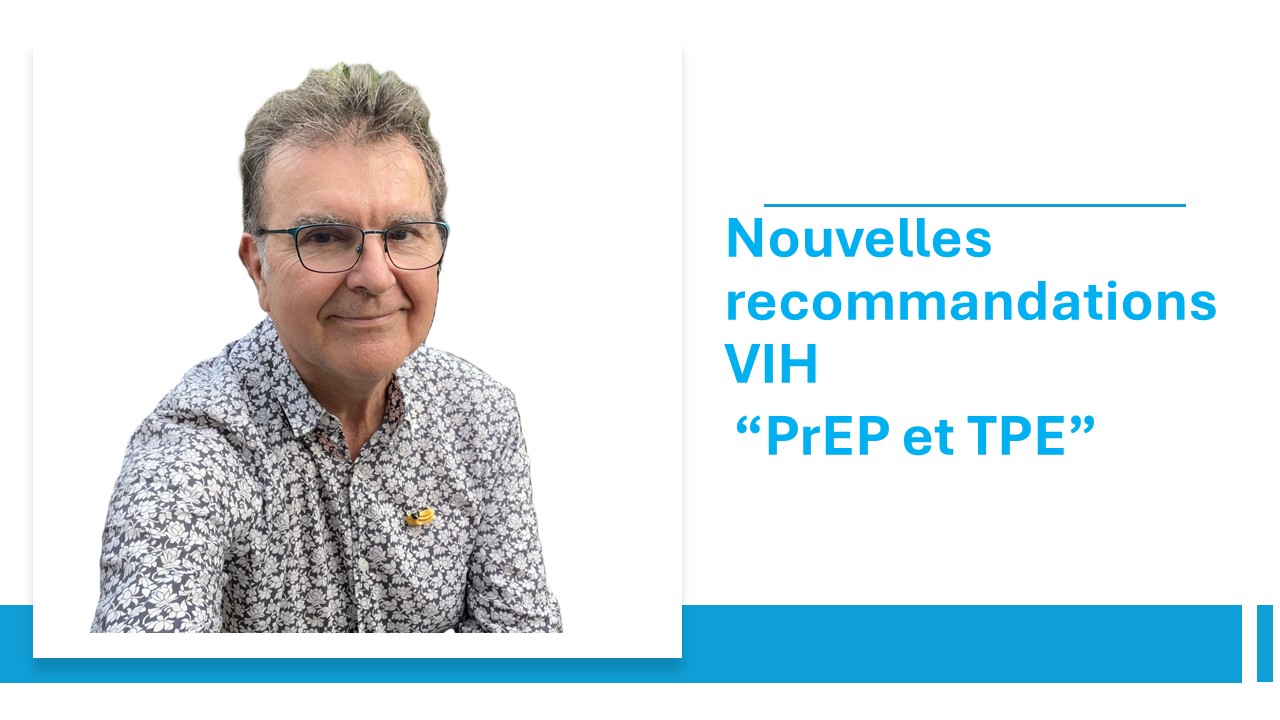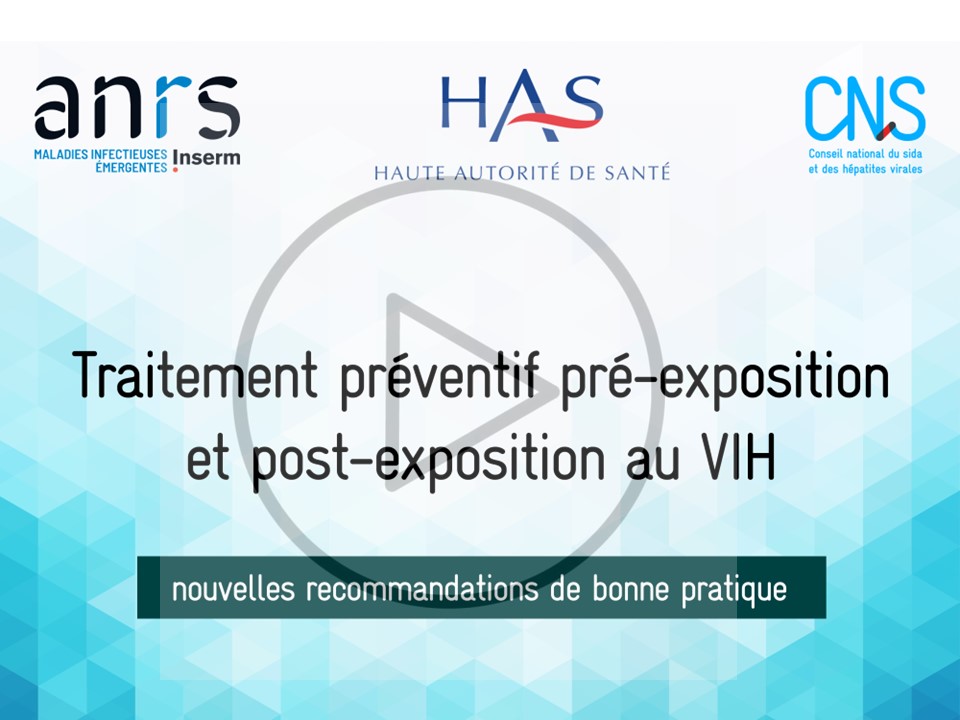
New recommendations for HIV pre- and post-exposure preventive treatment: interview with Dr Arvieux
Interview with Dr Cédric Arvieux, Rennes University Hospital
Last updated on 30 October 2024
In brief
2 new chapters of recommendations were put online in August 2024. The work is being carried out under the aegis of the ANRS MIE, the French National AIDS and Viral Hepatitis Council (CNS), and the Haute Autorité de santé (HAS). In an interview, Dr Cédric Arvieux, head of the working group, outlined the key aspects of these 2 chapters, with a section on pre-exposure prophylaxis (PrEP) and a section on post-exposure prophylaxis (PEP) for HIV.
What are the aims of the new PrEP recommendations?
Towards expanding the indications for PrEP
HIV pre-exposure prophylaxis (PrEP) is a fully-fledged tool in the strategy for preventing HIV infection, and its effectiveness has been demonstrated. However currently in France, most people diagnosed with HIV infection have identifiable exposure factors, which should have led to them being prescribed PrEP to prevent infection. We therefore need to broaden the indications, focusing of course on people at greatest risk of exposure, but also responding to requests from people who do not report any obvious excess risk of exposure: the decision to start PrEP must be a shared one.
Facilitating access to PrEP
A crucial point in these recommendations is to try to widen access to PrEP for young women from sub-Saharan Africa, a population heavily affected by HIV but under-represented among PrEP users. Broadening the range of prescribers to include professionals such as midwives is also envisaged as a way of facilitating access. In addition, the forthcoming introduction in France of injectable cabotegravir, administered every two months, could provide an additional PrEP opportunity for these women. The recommendations emphasise the simplicity of prescribing and monitoring PrEP, which no longer requires hospital consultation, and stress its proven efficacy.
The aim of the new recommendations is to update those issued in 2021 and widen access to PrEP, with particular emphasis on the simplicity of prescribing and monitoring procedures. The aim is to make PrEP more accessible, including to people who do not perceive themselves to be at high risk of exposure to HIV. The decision to prescribe PrEP must be shared between the patient and the doctor, taking into account the patient’s personal perception of the risk.
What are the indications for post-exposure prophylaxis (PEP)?
After high-risk sexual or blood exposure, post-exposure prophylaxis (PEP) can reduce the risk of HIV transmission.
PEP is prescribed when there is a proven risk of HIV transmission, i.e. when a source person has a detectable viral load. However, in France, the majority of HIV-positive people being monitored have an undetectable viral load, thereby reducing the risk of transmission. The “reservoir of risk” is therefore essentially made up of people who are not yet aware of their seropositivity. PEP is particularly recommended in high-risk situations, such as unprotected anal sex with men who have sex with men (MSM) or transgender women whose HIV status is unknown.
The French recommendations have adopted the same model as that which guided the UK recommendations, where treatment is recommended if the number of people to be treated to avoid infection is less than 10,000. If this number is between 10,000 and 100,000, treatment is to be discussed, and above 100,000, it is not recommended. For example, for vaginal intercourse, PEP is almost never indicated. However, in the case of anal intercourse unprotected by a condom with an MSM or trans person of unknown HIV status, it is systematically indicated.
However, as with PrEP, given the very good tolerance of post-exposure treatments, there is no reason to refuse an EIP to a person who considers it essential for their health, after explaining the benefit-risk balance of the treatment and the levels of risk as set out above.
How are PEP and PrEP linked?
Although not very effective on a large scale as a public health tool, PEP remains important for certain patients and can be a gateway to PrEP. It is therefore advisable to discuss PrEP with anyone presenting for an EIPT, and to switch directly to PrEP after the EIPT if the exposed person’s situation shows that exposure may be repeated. The transition is made easier by the fact that the molecules offered for oral PrEP and for PEP are very similar. It is now recommended that anyone who has been on PEP for 28 days and wishes to switch to PrEP should do so without interruption, even if this means measuring the viral load at the end of PEP if there is any doubt about a primary infection.
The recommendations focus on the choice of treatments that are effective, well tolerated and as inexpensive as possible.
Presentation webinar
A webinar dedicated to the presentation of the new recommendations by Dr Arvieux (leader of the working group), followed by a question and answer session, has been organised on Friday 11 October from 1pm to 2pm.
Programme
- 1.00 pm: Welcome and introduction, Pr Delobel, Department of Infectious and Tropical Diseases, Toulouse University Hospital, Inserm UMR 1291 – CNRS – University of Toulouse (Infinity)
- 1.10pm: Presentation of the new recommendations, Dr Cédric Arvieux, Department of Infectious Diseases, Rennes University Hospital, France
- 1.40pm: Questions and answers
- 2.00 pm: End of the webinar
Watch the replay!
Frequently asked questions
PrEP How do you choose between continuous or discontinuous TDF/FTC treatment?
The right regimen is the one that best suits the person taking PrEP. It is perfectly possible to switch from the continuous form to the discontinuous form and vice versa, depending on when you are having sex. The important thing is to take 48 hours of treatment after the last exposure.
At the time the recommendations were drawn up, the pharmacological data did not allow the discontinuous regimen to be proposed for cis women, due to the poor vaginal distribution of tenofovir. The discontinuous regimen (or PrEP 2-1-1) was therefore only indicated for cisgender men and trans women. However, the data are evolving, and it cannot be ruled out that the discontinuous regimen may be extended to women in the coming months, probably with a longer indication for post-exposure continuation (7 days) than for men (48 hours).
With the imminent arrival of PrEP using injectable Cabotegravir, how do you choose between oral and injectable PrEP?
Although the first clinical studies show that PrEP with injectable cabotegravir is superior to oral PrEP, injectable PrEP remains a second-line treatment due to the lack of large-scale experience in industrialised countries. It is, of course, essential in cases where PrEP with TDF/FTC is contraindicated (renal failure, intolerance to oral treatment). Outside these situations, it should be discussed if compliance with oral PrEP appears difficult, whether for the continuous or discontinuous regimen.
How to monitor safety and efficacy in people on PrEP with TDF/FTC or injectable cabotegravir
As the combination therapy is remarkably well tolerated, monitoring of biological tolerance is minimal, with occasional checks of transaminases and creatinine levels. Regular monitoring of exposure to STIs is also recommended. As regards syphilis, screening for asymptomatic forms and early treatment should be the rule. For the time being, we also recommend systematic screening and treatment of asymptomatic gonococcal and chlamydial infections, but this position could change in the light of the risks of emerging antibiotic resistance. Further studies are needed to address this major public health issue: early and systematic treatment can limit transmission chains, but increases the risk of antibiotic resistance, which is known to be a major risk in the case of gonococcus.
In the case of injectable cabotegravir, given the rare cases of failure, the best way of monitoring efficacy seems to be to carry out regular viral load tests, initially at short intervals and then every 4 months.
What HIV medicines are recommanded for PEP ?
No efficacy studies have been carried out on humans, and there are only a handful of tolerance studies on small numbers. The principle was therefore to select a treatment that was 1/ as inexpensive as possible 2/ well tolerated 3/ effective against the strains of virus circulating in France. The combination of doravirin/tenofovir-disoproxil/lamivudine meets all three of these criteria. It also has the advantage of containing the tenofovir-disoproxil/lamivudine combination, which will be the treatment proposed for PrEP in people who have an indication for PrEP as a relay to PEP.
PEP and sexual violence
The health pathways of victims of sexual violence are often complex, and the desire to protect them from STIs, including HIV, must be integrated without overloading these pathways. There is no scientific literature that allows us to estimate the risk of HIV transmission for a non-consensual sexual act compared with a consensual act. We do know, however, that being subjected to violence overall increases the risk of contact with HIV. For female victims of sexual violence who only have vaginal intercourse, the risk of transmission for heterosexual vaginal intercourse remains very low: the benefit/risk ratio must be weighed up between increasing the victim’s stress level by prescribing treatment, which may make her believe that the risk is high, and not prescribing treatment, which may be a source of stress in feeling unprotected. The victim’s opinion and a shared decision are essential in this situation.
Other recommendation chapters
- A webinar dedicated to the presentation of the new recommendations for cancer screening and management in people living with HIV by Prof. Makinson (leader of the working group) has been recorded. Read the full presentation and Q&A
- The new recommendations on ‘Pregnancy and HIV: the desire to have a child, care of the pregnant woman and prevention of mother-to-child transmission’ were published online on 31 May 2024. In an interview, Prof. Laurent Mandelbrot, head of the working group, presented the essential aspects of planning a pregnancy, measures to prevent mother-to-child transmission of HIV, and new perspectives on breastfeeding for women living with HIV.

2025 virology thesis prize: submit your applications
The prizes are jointly awarded by ANRS MIE and the Société française de virologie.
17 December 2025

